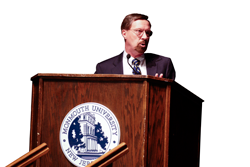The University hosted a sports panel “College Sports: Upon Further Review,” discussing the turbulent nature of the current commercialization of college athletes in Pollak Theatre on Nov. 8.
The panel included: University President Paul Brown; Dan Beebe, the former Commissioner of both the Big 12 and Ohio Valley Conferences; and Amy Perko, Executive Director of the Knight Commission, a website that attempts to ensure an educational focus for college athletes. Matt Harmon, a specialist professor for the communication department and broadcaster of the Monmouth men’s basketball and football teams, moderated the proceedings.
Several topics prevalent within college sports were discussed throughout the hour and a half-long panel; however, two recent rulings that could heavily impact the landscape of college sports were the central focus of the panel.
The first ruling, decided by the NCAA Division I board of directors, allows members of the power five conferences to have autonomy. This ruling permits the power five conferences, SEC, Big 12, Pac-12, ACC, and Big Ten, the authority to create some of their own legislation and rules for athletes. Because these schools generate exorbitant revenue and are under a different standard and level of expectation, they were given the right to control themselves.
“I understand the context for all this. The 65 schools representing the Big Five Conferences want autonomy from the other NCAA Division I schools like Monmouth University so they can decide for themselves what’s best for their student-athletes. After all, their world is far different from ours, replete with complex issues surrounding full scholarships, deferred compensation, or when a student-athlete can begin talking to a professional agent,” explained President Brown in an editorial he wrote for the Philadelphia Inquirer. “But make no mistake, the proposed reforms are but the onset of a broader transformation, the proverbial camel’s nose under the tent. They likely will propel and accelerate changes that will inevitably continue to blur the lines between major college athletics and professional sports.”
Distinguished institutions in the power five conferences will now have the responsibility of correctly governing their student-athletes. Perko said, “The overall conclusion was everyone still believed that it’s best to operate Division I sports under that big tent because there’s such an appreciation for March Madness and being inclusive of everyone. In terms of allowing those power five schools to now have autonomy, they can create certain rules in certain areas. In my view as long as the power five uphold the principles of college sports, they should be able to know when not to use that autonomy so that we don’t lose that big tent and the principles that bind college sports together.”
Beebe believes that the autonomy recently imposed was a necessary change. “I don’t think the [power five conferences] should be a separate entity. I think they do need to get the autonomy that they just got, to be able to address the extreme pressures of the media, public, and legal system that’s coming onto them now,” said Beebe.
The second ruling discussed within the panel was a case involving former UCLA basketball player Ed O’Bannon. O’Bannon sued the NCAA for using his and other college athletes images for commercial use. U.S. District Court Judge Claudia Wilken ruled in favor of O’Bannon.
According to the decision, “any rules or bylaws that would prohibit its member schools and conferences from offering their FBS football or Division I basketball recruits a limited share of the revenues generated from the use of their names, images, and likenesses in addition to a full grant-in-aid.”
NCAA president Mark Emmert said, “And we’ll probably continue to argue that in the coming months and beyond.” While the NCAA is expected to appeal the decision, the ruling could have a profound affect on student-athletes and force colleges to share some of the profit they are making from football and men’s basketball.
Perko maintained, “One of the main reasons for that autonomy was around providing scholarships that cover up to the cost of attendance. What has happened since then with the O’Bannon ruling is that the O’Bannon ruling really mandates that it be required. It may not be something that’s even in the power fives hands to do, in terms of creating that rule change.”
The ruling does not mean that college athletes will necessarily be paid right away. “I don’t agree with the terminology of paying players. They’re just increasing the grant and aid to full cost of attendance,” explained Beebe. The decision mandates that colleges place money gathered from sporting events into a trust that football and men’s basketball players will receive a percentage of after they graduate or their eligibility expires. A minimum of 5,000 dollars will be placed annually in the trust for each Division I football and men’s basketball player; meaning an athlete that stays for four years at an institution would receive no less than 20,000 dollars upon graduation.
Although the power five conferences have received much of the attention regarding additional incentives for student-athletes, these rulings will impact Monmouth athletes as well. “If the court decision were not overturned, then as a Division I basketball program Monmouth would be required to abide by whatever that court decision is,” said Perko.
“Monmouth could certainly decide to do that for their men’s and women’s basketball programs if that’s what they want to compete nationally in,” said Beebe.
While the panel’s discussion of these rulings brought some clarity, college athletics is still in a state of fluctuation. “I think right now your in one of those situations where there is a lot of stuff that is still undecided and a lot of things that are still up in the air,” explained Harmon. “Until there is finally a verdict on a lot of this stuff, I don’t really know how every school is going to be impacted.” The manner in which college sports are run has long been established; however, newly gained autonomy and the ruling in the O’Bannon case, could lead to a significant change in the near future.
PHOTO COURTESY of Kierra Lanni



